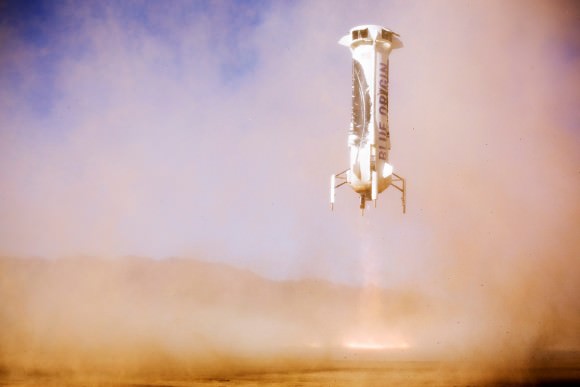On Friday, January 22nd, commercial space company Blue Origin successfully launched and landed its reusable rocket, New Shepard, at their launch facility in Texas. This is the second flight for New Shepard, showing that reusable rockets are on their way to becoming the launch system of choice. New Shepard launched, travelled to apogee at 101.7 kilometres, (63.19 miles) and then descended to land safely at their site in West Texas. This is the first successful reuse of a rocket in history.
Reusable rockets are an important development for space travel. Rockets are enormously expensive, and having to trash each rocket after a single use makes commercial space flight a real challenge. Blue Origin—and other companies like SpaceX—are blazing a trail to cheaper space flight with their reusable designs. This is great, not only for all the good sciencey reasons that we love so much, but because eventually civilian space enthusiasts may be able to travel past the Karman Line without having to sell all their possessions to do so. (Reserve your ticket here.)
This video shows New Shepard launching, travelling and sticking its landing.
At the heart of New Shepard is its dynamically gimballed engine, which aims itself as it approaches the ground. This system allows the rocket to land precisely and safely, and is at the heart of its reusability. It’s also a system that scales well: rather than New Shepard just showing that reusable rockets are a feasible concept, but will require significant advancements before being scalable to larger payloads, the gimballed engine system will actually perform better with larger mass. This is because of the inverted pendulum problem.
The Blue Origin website explains it well:
“Try balancing a pencil on the tip of your finger. Now try it with a broomstick. The broomstick is simpler because its greater moment of inertia makes it easier to balance. We solved the inverted pendulum problem on New Shepard with an engine that dynamically gimbals to balance the vehicle as it descends.”
The Space Shuttle was the first system to come close to being a Reusable Launch System (RLS), although it was only partially reusable. It reused its main engines, as well as two solid rocket boosters, though they took months of refitting. Other components of the shuttle were discarded after a single use. New Shepard reuses its whole system, other than some components like pyro igniters, and of course the parachutes from the crew capsule.

Blue Origin is on a roll, and they’ll be continuing to develop New Shepard. They plan to keep launching and landing New Shepard, and refining the system. They are also developing their next engine, the BE4, which will increase the system’s thrust by 500%.
New Shepard’s first flight took place in November 2015, and we covered it here.


“…but will require significant advancements before being scalable to larger payloads…”
I wonder why that is? Are they gimboling just the rocket nozzle or are they gimboling the entire engine mount and using flexible fuel lines?
@AQUA: I had to re-read that sentence a couple of times myself to figure out what he was trying to say, but the gist is this:
“Unlike other concepts, Blue Origin’s shouldn’t have much of a problem with up-scaling because adding more mass to the rocket makes the inverted pendulum problem easier to solve, rather than more difficult.” Of course, SpaceX already knows this, which is why they’re pushing to be able to land on tiny moving targets (aka, barges) a long way out to sea, rather than focusing on bringing everything back to the launch site.